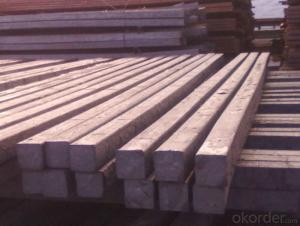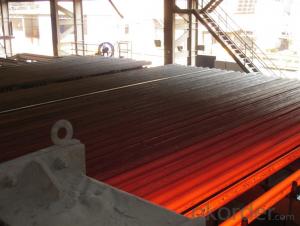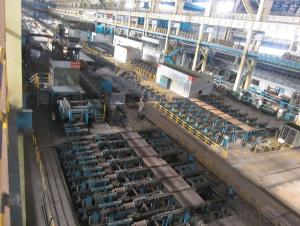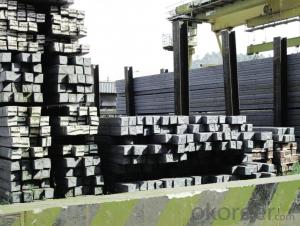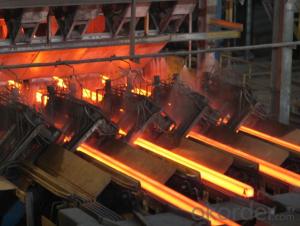Prime quality prepainted galvanized steel 660mm
- Loading Port:
- Tianjin
- Payment Terms:
- TT OR LC
- Min Order Qty:
- 100 m.t.
- Supply Capability:
- 10000 m.t./month
OKorder Service Pledge
OKorder Financial Service
You Might Also Like
Construction building material galvanized color prepainted cold
rolled steel coil
Prepainted steel sheet is coated with organic layer, which provides higher anti-corrosion property and
a longer lifespan than that of galvanized steel sheets.
The base metals for prepainted steel sheet consist of cold-rolled, HDG electro-galvanized and hot-dip
Alu-zinc coated. The finish coats of prepainted steel sheets can be classified into groups as follows:
polyester, silicon modified polyesters, polyvinylidene fluoride, high-durability polyester, etc
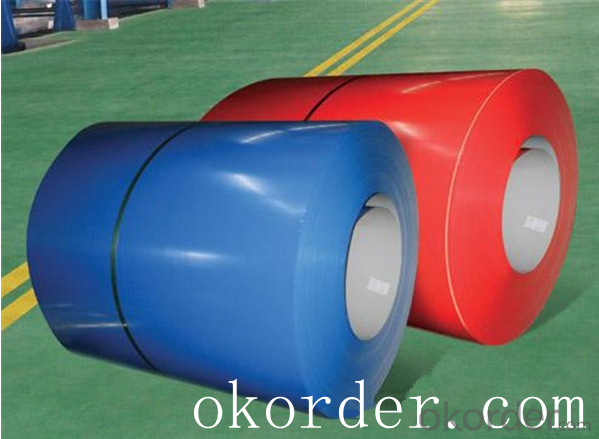
Standard and Grade :
Pre-paint galvanized steel coil | ||||
ASTM A755M-03 | EN10169:2006 | JISG 3312-2012 | ||
Commercial quality | CS | DX51D+Z | CGCC | |
Structure steel | SS GRADE 230 | S220GD+Z | CGC340 | |
SS GRADE 255 | S250GD+Z | CGC400 | ||
SS GRADE 275 | S280GD+Z | CGC440 | ||
SS GRADE 340 | S320GD+Z | CGC490 | ||
SS GRADE550 | S350GD+Z | CGC570 | ||
S550GD+Z | ||||
Application:
Outdoor | Roof, roof structure, surface sheet of balcony, frame of window, door of garage, rolled shutter door, booth, Persian blinds, cabana, etc |
Indoor | Door, isolater, frame of door, light steel structure of house, home electronic appliances, ect. |
Specifications
Commodity Name: Prepainted Galvanized Steel Coil
Standard: AISI, ASTM, DIN, GB, JIS
Grade: TDC52D+Z
Thickness 0.13-8.0mm
Width:600mm-1350mm
Zinc Coating:275g/m2
Polyester Coating Thickness:Top and Back coating thickness depend by Buyer Requirement.
Polyester Coating Type:2/2,1/2m,1/2.
Polyester Type: Polyester, silicone modified polyester, high durability polyester (HDP), polyvinylidene fluoride (PVDF)
Unit Roll Weight:5-20tons
Place of Origin Shanghai , China (Mainland)
Surface Treatment :Color Coated
Manufacture Progress:HRC-CRC-GALVANIZED-COLOR COATED
Application : Construction, electrical, transportation, steel plant, composite board plant, steel tile factory
Payment & Shipping Terms:T/T ,L/C, and FOB CHINA
Minimum Order Quantity: 25Tons
Packge Type: Moisture-proof paper inner,Steel outside,Bundle by steel rope.
Package in Container : Wood as a foot pad, wire rope reinforcement,PPGI steel coil tied together by steel rope.
- Q:What are the different types of rolling processes used for shaping steel billets?
- Steel billets can be shaped into desired forms using different rolling processes. These processes have been designed to transform raw materials into specific shapes and sizes. One widely used method is hot rolling, which involves heating the steel billet to a high temperature and passing it through a series of rollers. The pressure applied by the rollers causes the billet to elongate and change its shape. Hot rolling is commonly employed to produce large steel products like bars, rods, and plates. Another method is cold rolling, which does not require heating the steel billet. Instead, it is carried out at room temperature or slightly below. Cold rolling is known for its ability to produce accurately dimensioned finished products with a smooth surface. It is often used in the manufacturing of thin sheets, strips, and foils. Ring rolling is a third type of rolling process used for shaping steel billets. It involves rotating the billet between two rollers while exerting pressure. This method is particularly useful for creating seamless rings with hollow centers, which are commonly utilized in applications such as bearings and gears. Furthermore, skew rolling is a process used to shape steel billets into round balls or cylindrical forms. It entails rotating the billet at an angle to the direction of the rollers while applying pressure. Skew rolling finds extensive use in the production of grinding media for the mining and cement industries. In conclusion, the various rolling processes, including hot rolling, cold rolling, ring rolling, and skew rolling, offer distinct advantages and are suitable for specific applications. Each process plays a crucial role in shaping steel billets to meet the requirements of different industries.
- Q:How do steel billets differ from steel bars?
- Steel billets and steel bars, two intermediate steel products utilized in various industries for further processing, exhibit distinct differences. 1. Shape: Steel billets typically assume square or rectangular shapes, with cross-sectional dimensions ranging from a few inches to several feet. They are typically manufactured through continuous casting or hot rolling procedures. Conversely, steel bars adopt cylindrical shapes and maintain a uniform diameter throughout their length. They are usually produced through hot rolling or cold drawing processes. 2. Size: Steel billets tend to be larger compared to steel bars. Billets can measure from a few feet to several meters in length, while their cross-sectional dimensions can be customized based on the final product's requirements. Conversely, steel bars are typically manufactured in standardized sizes and lengths, such as 6 meters or 12 meters, and possess consistent diameters. 3. Production process: Steel billets are commonly generated through continuous casting or hot rolling methods. Continuous casting involves pouring molten steel into a mold, resulting in a solid billet. Hot rolling, on the other hand, entails passing the billet through multiple rollers to reduce its cross-sectional dimensions. In contrast, steel bars are produced through hot rolling or cold drawing processes. Hot rolling involves guiding billets through a series of rollers to achieve the desired shape and size, while cold drawing requires pulling the hot rolled bars through a die to further reduce their diameter and enhance their surface finish. 4. Applications: Steel billets primarily serve as raw materials for subsequent processing into various steel products, such as bars, rods, wires, and tubes. Additionally, they find application in the forging industry for the production of forged components. Steel bars, in contrast, enjoy a wide range of applications in construction, manufacturing, infrastructure, and automotive industries. They are commonly employed as reinforcement in concrete structures and in the production of shafts, gears, axles, and other machine parts. To summarize, steel billets and steel bars differ in terms of shape, size, production process, and applications. Billets, with their larger size and square or rectangular shape, serve as raw materials for further processing. Meanwhile, bars, with their cylindrical form and consistent diameter, find application in various industries for specific purposes.
- Q:What are the causes of internal cracks in continuous casting billet?
- The test according to the process of the sample for cooling, in order to study the effects of the three elements of the internal crack of continuous casting billet hot.
- Q:What are the different grades of steel used for making billets?
- There are several different grades of steel used for making billets, including low carbon steel, mild steel, medium carbon steel, high carbon steel, and alloy steel. The specific grade chosen depends on the desired properties and characteristics required for the intended application of the billets.
- Q:How do steel billets contribute to the mining industry?
- Steel billets are an essential component in the mining industry as they are used in the production of various mining equipment and infrastructure. These billets are often transformed into durable and strong steel products such as pipes, rods, and supports that are crucial for the extraction, transportation, and processing of minerals. Additionally, steel billets are also utilized in constructing mining machinery, vehicles, and structures, ensuring the industry's efficiency and safety.
- Q:What is alpha carbon? What is beta carbon?
- The C atom separated from the functional group is called C beta atom, and alpha carbon and beta carbon are not unique
- Q:Are steel billets used in the manufacturing of industrial machinery?
- Yes, steel billets are commonly used in the manufacturing of industrial machinery. They serve as a primary raw material for various components and parts, providing strength, durability, and versatility required in heavy-duty applications.
- Q:How are steel billets cast into shape?
- The process of continuous casting is used to shape steel billets. In this process, molten steel is poured into a copper mold that is cooled by water. The mold is in the shape of a billet, and as the steel is poured, it starts to solidify along the mold's walls. To ensure complete solidification, a water spray is employed at the bottom of the mold, rapidly cooling the steel. As the steel solidifies, it is continuously pulled out of the mold either by a set of rollers or a chain conveyor. Once the billet has solidified entirely, it is cut into desired lengths using a high-speed torch or saw. These cut billets are then transported to the next stage of the steel manufacturing process, such as rolling or forging, where they are further shaped into the final product. Continuous casting enables the production of steel billets with consistent cross-sectional shapes and sizes. This efficient process generates high-quality steel products while minimizing waste.
- Q:What are the main safety precautions in handling steel billets?
- The main safety precautions in handling steel billets include wearing appropriate personal protective equipment (PPE) such as gloves, safety glasses, and steel-toed boots to protect against potential injuries. It is important to use proper lifting techniques and equipment to prevent strains and back injuries. Additionally, ensuring a clean and organized work area helps to reduce the risk of slips, trips, and falls. Regular inspection and maintenance of equipment, as well as proper training and supervision, are crucial to maintaining a safe working environment when handling steel billets.
- Q:What are the different heat treatment processes applied to steel billets?
- There are several different heat treatment processes applied to steel billets, including annealing, normalizing, quenching, tempering, and case hardening. Annealing involves heating the steel to a specific temperature and then slowly cooling it to relieve internal stresses and improve its machinability. Normalizing is similar to annealing, but the steel is cooled in still air instead of a controlled environment. Quenching involves rapidly cooling the steel to harden it, typically by immersing it in a liquid or oil. Tempering is a process that follows quenching, where the steel is reheated to a specific temperature and then cooled again to enhance its toughness and reduce brittleness. Case hardening is a process where the surface of the steel is hardened while the core remains relatively softer, usually through the addition of carbon or nitrogen.
1. Manufacturer Overview |
|
|---|---|
| Location | |
| Year Established | |
| Annual Output Value | |
| Main Markets | |
| Company Certifications | |
2. Manufacturer Certificates |
|
|---|---|
| a) Certification Name | |
| Range | |
| Reference | |
| Validity Period | |
3. Manufacturer Capability |
|
|---|---|
| a)Trade Capacity | |
| Nearest Port | |
| Export Percentage | |
| No.of Employees in Trade Department | |
| Language Spoken: | |
| b)Factory Information | |
| Factory Size: | |
| No. of Production Lines | |
| Contract Manufacturing | |
| Product Price Range | |
Send your message to us
Prime quality prepainted galvanized steel 660mm
- Loading Port:
- Tianjin
- Payment Terms:
- TT OR LC
- Min Order Qty:
- 100 m.t.
- Supply Capability:
- 10000 m.t./month
OKorder Service Pledge
OKorder Financial Service
Similar products
New products
Hot products
Related keywords
